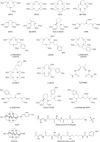Unconventional nuclides for radiopharmaceuticals
- PMID: 20128994
- PMCID: PMC4962336
Unconventional nuclides for radiopharmaceuticals
Abstract
Rapid and widespread growth in the use of nuclear medicine for both diagnosis and therapy of disease has been the driving force behind burgeoning research interests in the design of novel radiopharmaceuticals. Until recently, the majority of clinical and basic science research has focused on the development of 11C-, 13N-, 15O-, and 18F-radiopharmaceuticals for use with positron emission tomography (PET) and 99mTc-labeled agents for use with single-photon emission computed tomography (SPECT). With the increased availability of small, low-energy cyclotrons and improvements in both cyclotron targetry and purification chemistries, the use of "nonstandard" radionuclides is becoming more prevalent. This brief review describes the physical characteristics of 60 radionuclides, including beta+, beta-, gamma-ray, and alpha-particle emitters, which have the potential for use in the design and synthesis of the next generation of diagnostic and/or radiotherapeutic drugs. As the decay processes of many of the radionuclides described herein involve emission of high-energy gamma-rays, relevant shielding and radiation safety issues are also considered. In particular, the properties and safety considerations associated with the increasingly prevalent PET nuclides 64Cu, 68Ga, 86Y, 89Zr, and 124I are discussed.
Figures








References
-
- Pagani M, Stone-Elander S, Larsson SA. Alternative positron emission tomography with non-conventional positron emitters: effects of their physical properties on image quality and potential clinical applications. Eur J Nucl Med. 1997;24:1301–1327. - PubMed
-
- Welch MJ, Kilbourn MR, Green MA. Radiopharmaceuticals labeled with short-lived positron-emitting radionuclides. Radioisotopes. 1985;34:170–179. - PubMed
-
- McQuade R, Rowland DJ, Lewis JS, Welch MJ. Positron-emitting isotopes produced on biomedical cyclotrons. Curr Med Chem. 2005;12:807–818. - PubMed
-
- Blower P. Towards molecular imaging and treatment of disease with radionuclides: the role of inorganic chemistry. Dalton Trans. 2006:1705–1711. - PubMed
-
- Lewis JS, Singh RK, Welch MJ. Long lived and unconventional PET radionuclides. In: Pomper MG, Gelovani JG, editors. Molecular imaging in oncology. New York: Informa Healthcare USA Inc; 2009. pp. 283–292.
Publication types
MeSH terms
Substances
Grants and funding
LinkOut - more resources
Full Text Sources
Other Literature Sources
Research Materials
